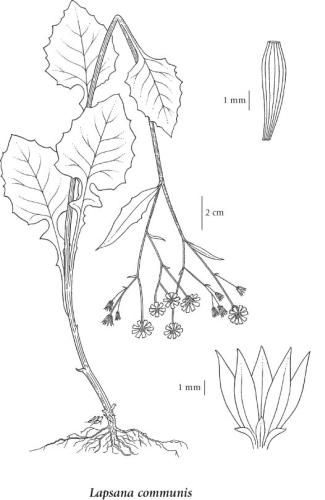Lapsana communis L.
nipplewort (common nipplewort)
Asteraceae (Aster family)
Introduction to Vascular Plants
nipplewort (common nipplewort)
Asteraceae (Aster family)
Introduction to Vascular Plants
Species Information
General:
Annual herb from a fibrous root; stems erect, branched above, solitary, exuding milky juice when broken, 0.3-1.5 m tall.
Leaves:
Basal leaves lacking; stem leaves alternate, toothed or occasionally basally lobed, egg-shaped to almost round or rounded, thin, lower ones stalked, upper ones more or less unstalked, toothed, 2.5-10 cm long, 2-7 cm wide.
Flowers:
Heads with strap-shaped flowers, several to many in an elongate to rounded inflorescence; involucres 4-8 mm tall; involucral bracts linear-lanceolate, the mostly 8 bracts evidently keeled at least toward the base; ray flowers yellow, usually about 13.Fruits; Achenes nerved, oblong, curved, tips rounded, 3-5 mm long, glabrous; pappus lacking.
Illustration

If more than one illustration is available for a species (e.g., separate illustrations were provided for two subspecies) then links to the separate images will be provided below. Note that individual subspecies or varietal illustrations are not always available.
Illustration Source: The Illustrated Flora of British Columbia
Ecology
Ecological Framework for Lapsana communis
The table below shows the species-specific information calculated from
original data (BEC database) provided by the BC Ministry of Forests and Range.
(Updated August, 2013)
The table below shows the species-specific information calculated from
original data (BEC database) provided by the BC Ministry of Forests and Range.
(Updated August, 2013)
| Site Information |
Value / Class |
||
|
Avg |
Min |
Max |
|
| Elevation
(metres) |
73 | 24 | 122 |
| Slope
Gradient (%) |
27 | 27 | 27 |
|
Aspect (degrees) |
0 | ||
| Soil
Moisture Regime (SMR) [0 - very xeric; 4 - mesic; 8 - hydric] |
5 | 2 | 7 |
| Modal
Nutrient Regime
Class |
D | ||
| #
of field plots species was recorded in: |
4 | ||
| Modal
BEC Zone Class |
CDF | ||
|
All BEC Zones (# of stations/zone) species was recorded in |
CDF(4) | ||
|
Source:
Klinkenberg 2013
|
|||